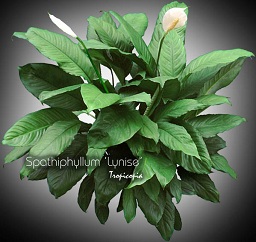Table of contents
Peace lily

Latin Name: Spathiphyllum ‘Lynise’
Category: Spathiphyllum
Family: Araceae
Origin: Cultivar
Climate: Tropical
Growing Zones: 11-11
Care Instructions
The Peace lily (Spathiphyllum ‘Lynise’) is a tropical plant that originates from Cultivar. This spathiphyllum plant belongs to the Araceae family and is well-suited for growing in USDA zones 11-11.
Complete Care Guide for Peace Lily (Spathiphyllum ‘Lynise’)
Watering Requirements
The Peace Lily thrives in consistently moist soil, but it is crucial to avoid overwatering, which can lead to root rot. Water the plant when the top inch of soil feels dry to the touch. Typically, this means watering once a week, but frequency may vary based on environmental conditions such as humidity and temperature. During the growing season (spring and summer), you may need to water more frequently, while in the dormant season (fall and winter), reduce watering to allow the plant to rest. Always use room temperature water, and consider using distilled or rainwater to prevent mineral buildup in the soil.
Light Conditions
Peace Lilies prefer bright, indirect light but can tolerate low-light conditions, making them ideal for indoor environments. Direct sunlight can scorch their leaves, leading to brown tips and edges. If you notice the plant stretching towards the light, it may be a sign that it needs more brightness. A north or east-facing window is often the best location, while south or west-facing windows should be filtered with sheer curtains to diffuse the harsh rays. If the leaves start to yellow, it may indicate too much direct sunlight, while dark green leaves can suggest insufficient light.
Soil Preferences
Peace Lilies thrive in well-draining, rich potting soil that retains moisture without becoming waterlogged. A mix of peat moss, perlite, and pine bark works well to provide the necessary drainage and aeration. It is advisable to repot your Peace Lily every 1-2 years to refresh the soil and provide more space for growth. During the growing season, you can feed your plant with a balanced, water-soluble fertilizer every 6-8 weeks to promote healthy growth and flowering. Be cautious not to over-fertilize, as this can lead to salt buildup and damage the roots.
Pests and Diseases
Common pests that may affect Peace Lilies include spider mites, aphids, and mealybugs. Regularly inspect the undersides of leaves and the stems for signs of infestation. If you notice pests, treat them promptly with insecticidal soap or neem oil, ensuring to cover all affected areas. Additionally, Peace Lilies can be susceptible to diseases such as root rot and leaf spot. Root rot is often caused by overwatering, so ensure proper drainage and allow the soil to dry out between waterings. Leaf spot can be managed by improving air circulation around the plant and avoiding overhead watering to keep the leaves dry.
Special Care Tips
To keep your Peace Lily healthy and thriving, consider the following special care tips: First, wipe the leaves with a damp cloth regularly to remove dust and improve photosynthesis. This also helps prevent pests from settling on the leaves. Second, Peace Lilies are sensitive to cold drafts and sudden temperature changes, so place them away from air conditioning vents and open windows during colder months. Lastly, if your Peace Lily is not blooming, it may need more light or a boost in nutrients, so adjust its location or fertilization schedule accordingly. Remember that Peace Lilies are also mildly toxic to pets if ingested, so keep them out of reach of curious animals.








